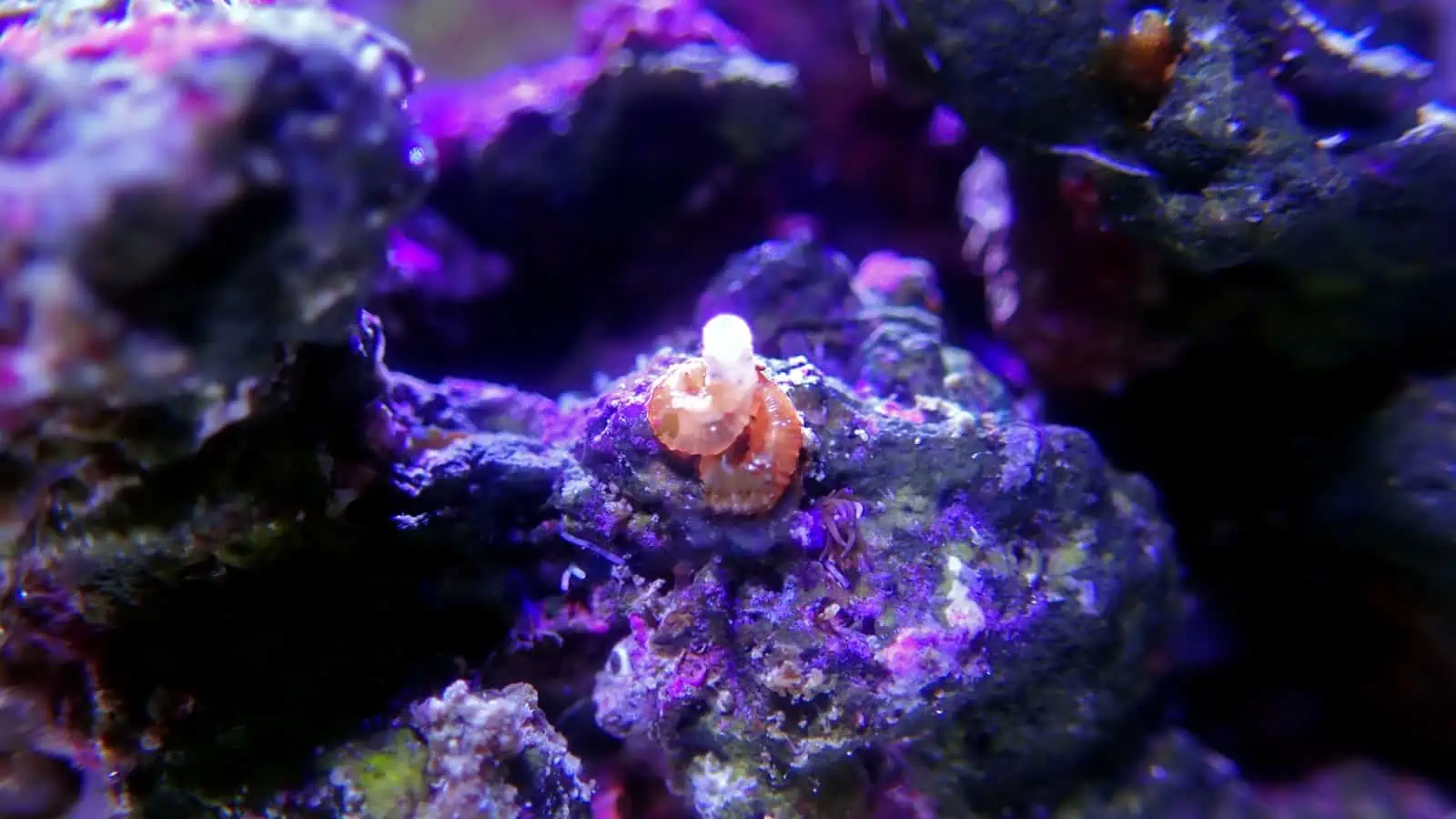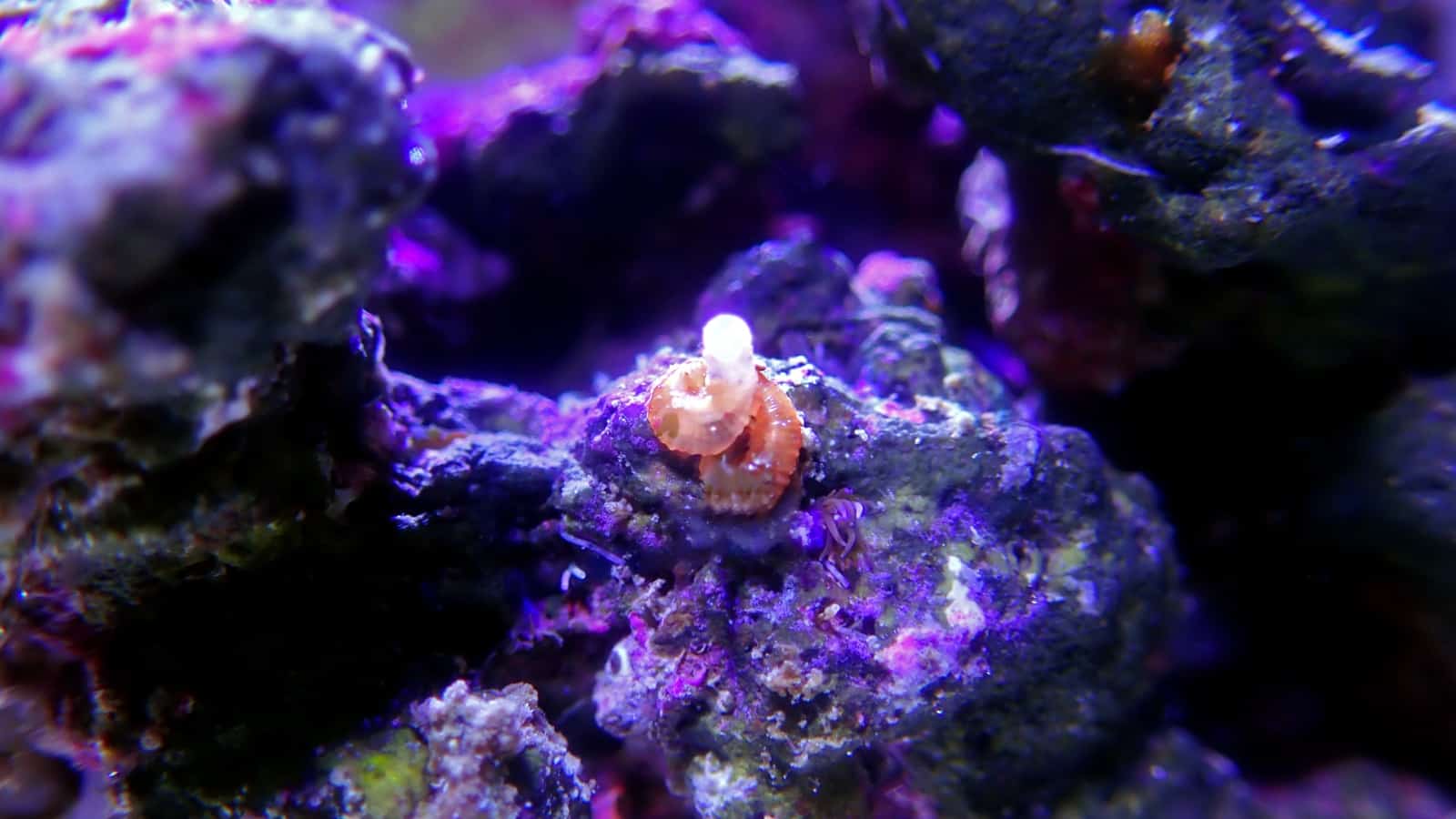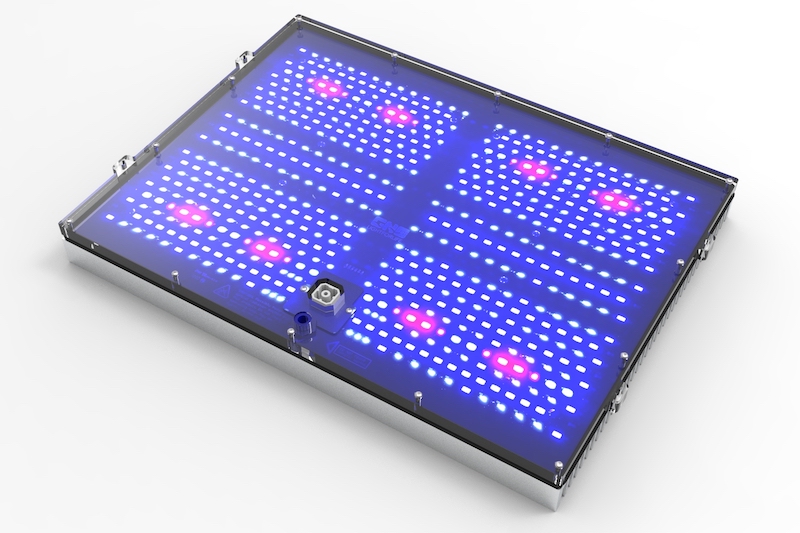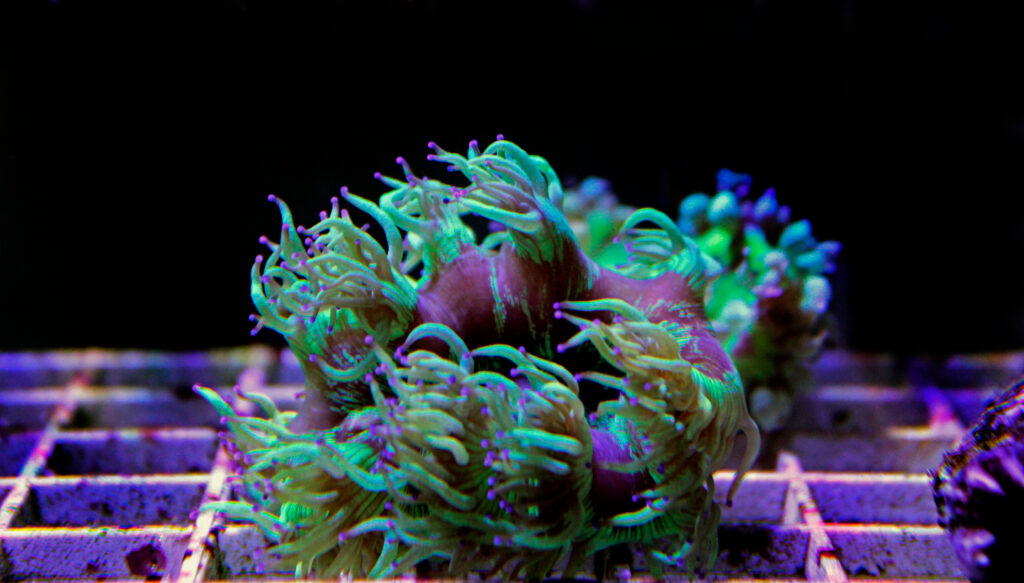If you have a reef tank, you’ll likely enjoy having a few snails in your tank as good company for your other invertebrates and as part of a cleanup crew.
However, Vermetid snails are quite another matter. These snails are pests, and you must get rid of them immediately.
But what’s so bad about Vermetid snails? Where do they come from? And how can you remove them from your tank for good?
Vermetid snails can cause damage to your corals once they become established and spread like wildfire! The snails find their way into your tank by hitchhiking on live rock, snail shells, and coral frags. There are various ways to kill these pests, including drying them out, using chemicals to kill them, and even supergluing their tubes closed!
Read this informative guide to learn more about the dreaded Vermetid snails and how to deal with them!
Vermetid Snail – At a Glance
| Vermetid Snail Info | |
|---|---|
| Scientific Name: | Vermetidae |
| Common Name (species) | Vermetic snail, Worm snail |
| Family | Vermetidae |
| Origin | The Caribbean |
| Diet | Organic debris |
| Temperature Range | Tropical |
| Water type | Saltwater |
| Breeding | Broadcast spawner, prolific breeder |
What Are Vermetid Snails?
Vermited snails belong to a group of uncoiled, sessile, suspension feeders that include over 160 known species of marine gastropods.
These snails are a unique group characterized by their uncoiled shells, permanently attached to a hard substratum. The creatures can be solitary or live in large groups and are found in tropical and temperate seas throughout the world.
What Do Vermetid Snails Look Like?
Unlike common snail species, Vermetid snails lack a coiled shell and look more like tubeworms than snails. Although the snails begin life with a normal coiled shell, it becomes untwisted during the post-larval stage of their life.
Interestingly, unlike other snail species, once the Vermetid snail finds a suitable place to settle, it will remain there, firmly attached to rock or any other hard substrate. The snail then begins to build its strong, tube-like calcium shell. Vermetid snails do not grow on the skin or fleshy part of corals and do not settle on wood, preferring something completely inert to attach themselves to.
Vermetid snails can build tubes varying from 0.4 inches to 4 inches or greater, depending on the species. Sometimes the tubes are straight, but they can also have a branch-like appearance. The shells are usually creamy-brown striped with dark lines, and the surface is generally smooth except for the growing lines.
Interestingly, the snails do not live in the tubes but instead live at the base of their construction, using the tubes as doors. Some species of Vermetid snails have an operculum, which they use to close the tubes as other snail species do.
Why Are Vermetid Snails Considered a Pest?
In nature, Vermetid snails are extremely important reef builders in the marine environment. But in the home reef tank, they can be extremely destructive, which is why they are widely viewed as a nuisance pest species.
The main complaint from aquarists is that the snails spread out mucus feeder webs between the Coral heads, preventing them from opening. As a result, the coral doesn’t get enough food, weakens, and eventually dies. However, in some cases, SPS grows over the Vermetid snails’ tubes, effectively suffocating them.
That said, most hobbyists prefer not to risk having these snails living in their reef tanks and try to get rid of them as soon as possible.
At Risk!
Some species of Vermetid snails are listed as being threatened in the Mediterranean Red Data Book of threatened marine vegetation (UNEP/IUCN/GIS Posidonie, 1990). That’s interesting since marine scientists use the snails as a bioindicator for Global environmental changes, including surface seawater temperatures, rising sea levels, and ocean acidification.
What Do Vermetid Snails Eat?
All species of Vermetid snails are filter feeders, catching and eating tiny particles of matter from the water flowing over them. The snails’ diet includes detritus, plankton, and food fragments. The Vermetid snail feeds by excreting a mucus net from its large pedal gland and casting it over the water via specialized, grooved tentacles.
Unlike most passive suspension-feeding species that use a fixed filtering organ, the Vermetid snail’s fishing net can change its size and shape according to the current conditions. In addition, the net can sometimes be much larger than the animal itself, sometimes extending up to 4 square inches!
The net is left in the water, close to the substrate, for 20 to 40 minutes. After that, the snail draws its fishing net into its mouth and ingests it with any trapped food particles.
Fascinatingly, scientists have seen Vermetid snails fail to produce a mucus net when kept in still water conditions. The net is extended in the direction of the current. It happens mostly in high-flow conditions, so filter feeding appears only in environments where the current is relatively strong.
Vermetid Snail Breeding
Despite its stationary lifestyle, the Vermetid snail has evolved a unique reproductive method and development, enabling the species to easily and effectively colonize new areas.
Male snails produce pelagic spermatophores that drift in the water, becoming trapped by the female snail’s mucus net. As the female snail transfers the net to her mouth, she bites down on it, causing the sperm to be ejected into the mantle cavity, where it fertilizes her eggs.
Depending on the species, Vermetid snails can carry a few dozen egg capsules, each containing up to 40 embryos. Once hatched, the juvenile snails choose a suitable spot and attach themselves to it, usually within as little as 24 hours.
Within two to three days after attachment to the substrate, the juvenile snails morph into their adult feeding form. So, you can see just how quickly Vermetid snails can take over your tank!
How Do Vermetid Snails Get Into Your Tank?
It’s surprisingly and alarmingly easy for Vermetid snails to get into your reef tank and wreak havoc on your corals. Usually, the snails hitchhike into your tank on corals, coral frags, and live rocks, quickly making themselves at home. They can also arrive as eggs with new livestock, including shrimp, snails, and even fish, floating unseen in the water of the transport bag.
The eggs are too tiny to spot at first, and it can take several weeks or even months until you notice a few odd-looking tubes in your tank, spreading a weird web into the water. Then you realize you have a Vermetid snail invasion on your hands!
How To Remove Vermetid Snails From Your Aquarium

Of course, the best way to keep Vermetid snails out of your reef tank is to quarantine new livestock for a month before adding it to your main display tank. However, no matter how careful you are, your tank could still get infected.
So, how do you get rid of Vermetid snails?
The first thing to know is that these creatures are incredibly resilient and take a lot of shifting! However, you can try a few things to rid your tank of these pesky pests.
Remove Them by Hand
The safest and most effective way of dealing with Vermetid snails is to remove them by hand. to do that, use coral cutters or dental tools to take out the rock or coral to which the snails are attached.
You must remove the base of the snail’s tube using a scalpel or razor. Be extremely careful, as these snail’s shells can be very sharp, and you could easily cut yourself. As soon as the snail senses danger, it will shrink down to the base of its protective shell. Therefore, if you cut the top off the tube, the snail will grow a new one.
Puncture The Tube
To puncture the snail’s tube, you need an awl or thick sewing needle. Carefully insert the needle into the base of the tube where the snail is hiding and lance it.
Be careful if you decide to use this method of killing the snails, as too many in the tank will cause an ammonia spike that could harm your fish and other livestock.
Superglue
If you don’t want to disrupt your corals or live rock, you can glue the anterior end of the snail’s tube to cut off its oxygen supply and prevent it from feeding and reproducing. The main problem with this eradication method is that the dead snail will rot inside its shell, potentially causing an ammonia strike.
Use Predators
Although it’s true to say that Bumblebee snails eat other snail species, including Vermetid snails, this is rather a hit-and-miss approach that doesn’t always work.
Bumblebee snails don’t always bother with other snails, and if the Vermetids hide in small crevices, the Bumblebee snails won’t be able to get at them anyway.
It’s misreported that Emerald crabs and Yellow Coris Wrasse eat Vermetid snails. That’s not true.
Use Coral Snow
Coral snow removes suspended particles from the water and clarifies it, effectively starving the Vermetid snails. Sometimes, combining that with feeding less gets rid of Vermetid snails.
Chemical Treatments
Although we prefer to use natural methods of Vermetid snail removal, you can try using chemical treatments to get rid of the snails and wipe them out once and for all. Ask the experts at your local fish store or your vet for a device on what chemical treatments are the most effective for eradicating this particular aquarium pest.
Prevention
Of course, prevention is much better than cure, so it’s better to prevent Vermetid snails from getting into your tank in the first place.
- The most effective way to do that is by quarantining absolutely everything before adding it to your main display aquarium.
- If you spot Vermetid snails at your local fish store, do not buy anything from there!
- Quarantine all new corals for at least 30 days.
If you notice any Vermetid snails in the quarantine tank, you can decide whether you want to eradicate them and then add the new rock or livestock to your display aquarium.
FAQs
In this part of our guide, we answer a few of the most frequently asked questions about vermetid snails.
Q: Where Do Vermetid Snails Come From?
A: Vermetid snails get into your tank by hitchhiking on live rock, snail shells, and coral frag plugs. These pests can also come into your tank as eggs floating unseen in the water of a transport bag from your local fish store.
Q: Does Anything Eat Vermetid Snails?
A: The only known predator of Vermetid snails is the carnivorous Bumblebee snail that makes a meal of other snail species and mollusks. That said, some hobbyists have reported that Bumblebees simply ignored the Vermetid snails, so the jury’s out!
Q: How Do Vermetid Snails Spread?
A: The Vermetid snail is a broadcast spawner that explodes in population in massively short timescales. That means a tiny number of snails can balloon into thousands in no time at all.
Final Thoughts
Vermetid snails are a pest you don’t want in your reef tank. These nuisance snails anchor themselves permanently to rock or coral and filter feed by spreading a mucus net into the water around them. That can damage or even starve your corals.
In addition, the snails reproduce at an alarming rate, quickly depositing dozens of babies into your tank. Within a matter of weeks, you can end up with a full-scale invasion!
You can kill Vermetid snails by gluing their tubes, lancing them with an awl or needle, starving them by using coral snow, or prizing the snails off their chosen substrate with a scalpel. The snails get into your tank on live rock, corals, and frags, so the best way to keep them out is by quarantining all new livestock for at least a month to be sure the newbies are pest-free.
Did you have Vermetid snails in your tank? How did you get rid of them? Tell us in the comments box below.



